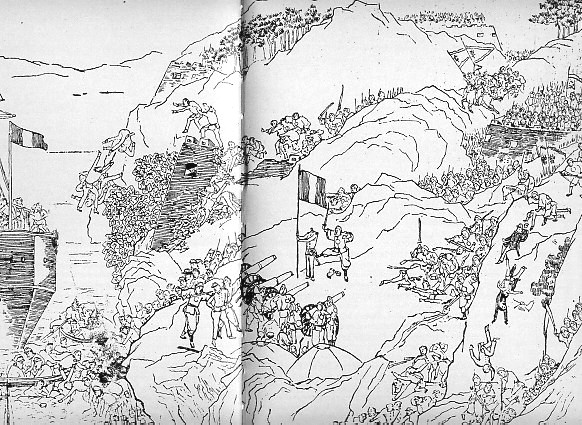Special thanks to Florence Duchet for research assistance on this week’s column.
This Week in China’s History: August 5, 1884
For some time, tension had been building over the fate of Taiwan, as leaders in far-off capitals postured and planned. No one was shocked when warships appeared off Taiwanese shores. An ultimatum to surrender went unanswered, and after an artillery barrage, troops went ashore to occupy Jilong, the island’s second-largest seaport and the closest to the Chinese mainland.
Scenarios for an amphibious assault on Taiwan are on people’s minds these days, forced into the headlines with the (not-at-all) surprise visit of U.S. House Speaker Nancy Pelosi. But the above does not describe a hypothetical landing by PRC forces trying to forcibly unite the two sides of the strait. In the summer of 1884, French forces, frustrated by Qing refusal to comply with their colonial wishes in Indochina, attempted to demonstrate their power by taking Taiwan. When French Admiral Sébastian Lespès sent his marines ashore on August 6, a localized conflict threatened to push two of the world’s most expansive empires to war.
The landing didn’t go according to the French plan; Qing forces held Jilong, at least for the moment, but Chinese optimism proved unfounded as well. The 1884-85 Sino-French war had no clear winner and changed little about the balance of power in East Asia, though thousands died and governments fell making the effort.
As with today, the clash was rooted in dueling imperial ambitions and competing claims about national interest, sovereignty, and “respect.” The 19th century is often viewed through the lens of European colonial expansion, and to be sure, the “New Imperialism” was a defining feature of the era. But Europe was not acting in a vacuum. In Southeast Asia, for example, China had behaved as an imperial power for some time, infringing on the sovereignty of various states in the region (tensions of this sort led to the 1740 Batavia massacre. One such state was Vietnam.
Vietnamese armies had evicted the Chinese from Indochina in the 1420s, but since that time, emperors of both the Ming and Qing dynasties had demanded that Vietnam offer tribute to Beijing (or Nanjing), with varying degrees of success. This brought Chinese policy into conflict with France, which focused its imperial ambitions on the Indochinese Peninsula. A steady, violent expansion of the French presence there resulted in formal colonies in the 1860s (technically, three protectorates — Annam, Tonkin, and Cambodia — and the colony of Cochinchina, in southern Vietnam).
The French used their base in Vietnam to expand north into Guangxi, Guangdong, and Yunnan. A treaty signed in 1874 to address the conflict was a mixed success: France interpreted it as confirming its control over Vietnam, while the Qing refused to implement the treaty. Tensions persisted for a decade, escalating into a short war that came to an end in the spring of 1884 with the Tientsin Accord.
But this treaty didn’t solve things either. Chiefly, the treaty called for Qing troops to withdraw from Tonkin, but did not specify a date for accomplishing this. Amid the uncertainty, French troops attempted to occupy territory that they expected the Qing to relinquish. Instead, the two sides clashed in battles (French sources say ambushes) along the Qing-Tonkin border.
The Qing court was divided on the question of escalation with France. Commanders in favor of a full-scale war chose not to inform Chinese troops in Vietnam to withdraw, hoping to provoke an aggressive French response and, in their calculation, reignite the conflict.
Taking the bait, many French officials favored wide coastal actions that would demonstrate French military superiority. The centerpiece of this plan was an attack on the Fuzhou arsenal and shipyards — one of China’s most important and modern military installations — and the Qing fleet anchored there. This assault would both send a message and also inhibit China’s ability to contest French operations on the southern coast. Others advocated for more limited attacks that would compel the Qing to comply with (the French interpretation of) the Tientsin Accord, but stop short of war.
An attack on Jilong — then more familiarly romanized as Keelung — was proposed as a compromise. Jilong could be a bargaining chip in any potential negotiations with the Qing government, but it was not as important as Fuzhou, which would leave the Chinese side little choice but to mobilize for war. As early as February 1884, French Admiral Amédée Courbet had worked out a plan to seize Jilong, concluding that the port could be easily taken and held.
By the time the plan was implemented, however, Qing officials had gotten wind of French intentions and fortified the port. Instead of the 500 soldiers that had been stationed there in winter, there were 10 times that number when the French attack came in early August. After an initial bombardment on August 5, a French landing party went ashore, but it was quickly repulsed by a much larger Qing army and forced, under fire, to re-embark.
The clash in Taiwan precipitated a war — really the last chapter of the smoldering conflict that had begun in 1873 — that was to the credit of neither side. The French, determined to redeem their failure on Taiwan, deployed their Far East Squadron against the Fuzhou Navy Yard (which ironically had been constructed largely by French engineers). Most of China’s Fujian fleet — one of four regional fleets — was sunk or badly damaged.
The French followed up this victory with a failed campaign back on Taiwan. Although Keelung was finally occupied in early October, the French were unable to proceed beyond this one town. Qing forces defeated the French near the town of Tamsui in late October, leading to a stalemate.
The impact of the fighting was keenly felt in the two empires’ capitals.
In Beijing, the influence of the pro-war party grew, even though enthusiasm to fight the French had dampened following the destruction of the Fuzhou shipyards. In France, where the war was never popular but an easy victory was expected, the difficulties in Taiwan undermined the government. Jules Ferry would remain as prime minister for only a few more months. In April 1885 he was forced to resign, and his successor, Henri Bresson, quickly negotiated an end to the war.
Both sides came away unsatisfied. France failed to inflict the defeat its leaders had planned, and still trailed Britain by a wide margin in terms of its colonial ambitions in China. For the Qing, the war had weakened its overall standing relative to the French: the war’s resolution recognized French power in Vietnam, positioning an imperial power on China’s southern border. Perhaps most damaging, the stalemate failed to unify Qing policy in a way that might have prevented the catastrophes of war with Japan a decade later.
All historical analogies are imperfect, and this one may be particularly flawed. Today’s PRC is not the Qing dynasty of the 19th century, struggling to modernize under constant pressure from European empires. The United States is the world’s largest military and economic power — no parallel to France under the Third Republic. And Taiwan today is an economic power and an important strategic player, far from the isolated backwater of the late 19th century.
Still, the specter of an ill-advised war, with no clear winner and political prices to pay in capitals across the world, seems part of today’s equation, even if the specifics are very different. It may be that nuclear weapons reduce the risk of full-scale war, but any time live weapons in hostile hands come into proximity, risks are real, and outcomes are seldom rational or predictable.
This Week in China’s History is a weekly column.






